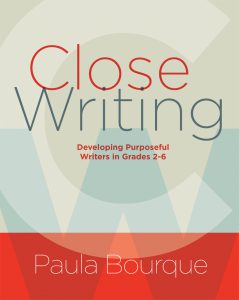
One method she uses to encourage careful reading is “cranium reading,” a technique in which the reader covers her ears and reads the work to herself. The idea is that “when things are different, we tend to pay more attention to them.”The bulk of the book (Part 2) is “Close Writing Lessons,” and these include close listening, close looking (at mentor texts), close modeling (based on mentor authors), increasing volume and stamina (of writing output), rereading and reflecting, revising, editing, assessing, publishing, and performing. The mentor texts referred to are those of former students and of published authors. Each chapter is illustrated with stories and photographs of teachers and students in action and of student work, and each chapter ends with “considerations for English language learners” and a bullet point summary.
Some of the clever ideas that Bourque suggests are sliding a piece of writing into a sheet protector and editing on the plastic with dry erase markers, having students deliberately write badly, having instructors try out their own assignments, asking students what it is about writing that makes them feel good or bad, using text-to-speech software to hear the writing, acting out dialogue, and reading the work to a listener who can then ask questions if something is not clear. These are just a few of Bourque’s many excellent techniques to use, regardless of the grade level of the students. Bourque is an enthusiastic teacher and writing promoter. She encourages children to think of themselves as authors and schools them in the techniques that actual authors use. She uses authors’ works as mentor texts and has Skyped with authors before in the classroom. Part 3 of the book includes short interviews with twelve authors, and each of them emphasized their love of reading and re-emphasized that good writing takes time to read, reread, listen to, revise—all techniques that Bourque discusses and all techniques that need to be implemented in writing curricula now.
Gayle Roller has a master of arts degree from California State San Marcos and is completing a TESOL certificate at California State Polytechnic University, Pomona. She has taught developmental composition courses at the community college level in the past and is looking forward to teaching ESL classes in the near future.
Close Writing: Developing
Purposeful Writers in Grades 2–6
Bourque, Paula
Stenhouse, Portland, ME: (2016).
ISBN: 9781625310538 $26






